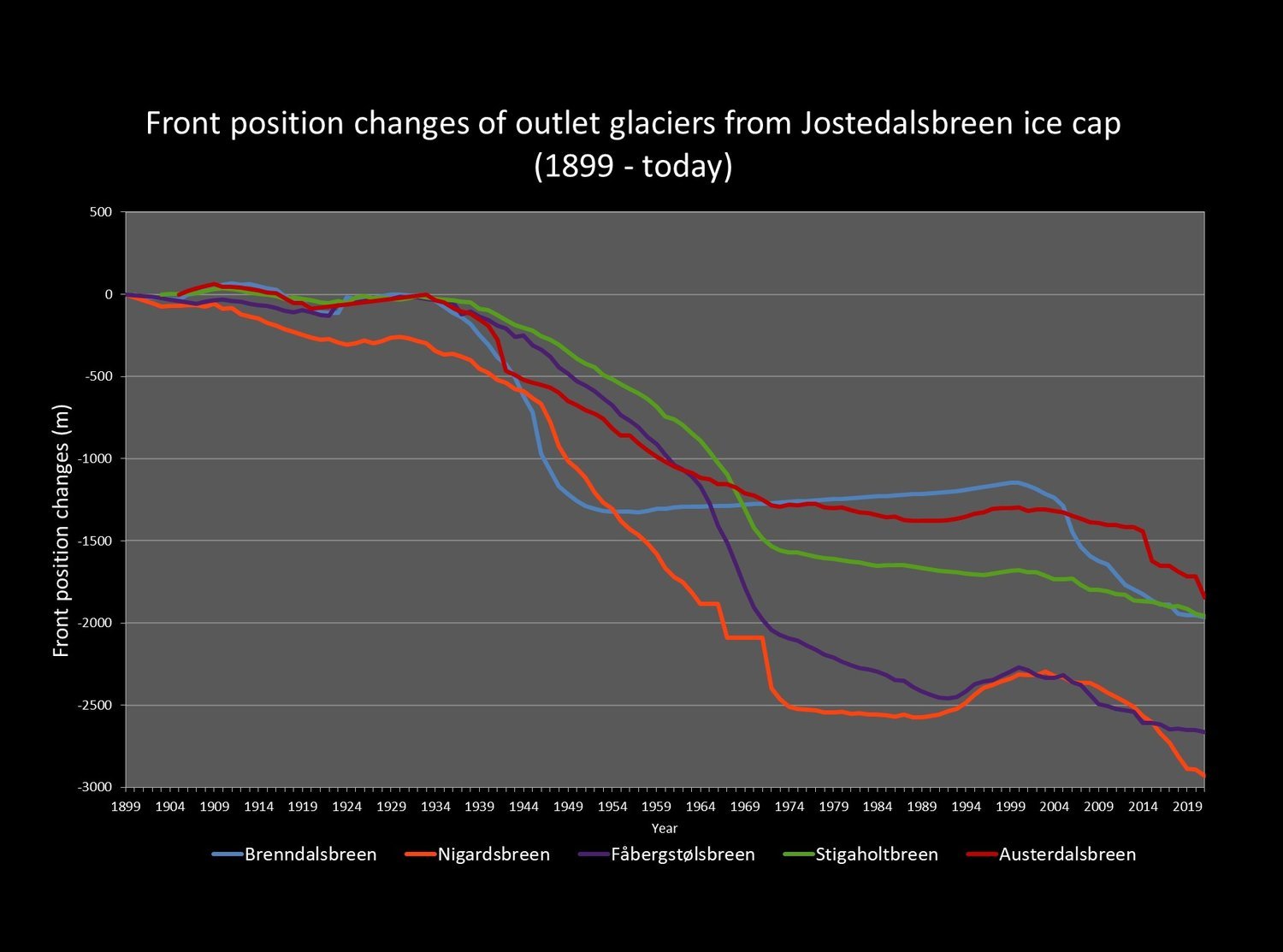Glacier measurements on Jostedalsbreen glacier
Tunsbergdalsbreen glacier 1959. Photo: John Price.
Jostedalsbreen, with its many outlet glacier, has both in the past and at present time been interesting for carrying out glacier measurements. The Norwegian Glacier Museum has collected front position measurements from Jostedalsbreen from 1900 to the present day.
Some of the glaciers have long measurement series, some have only been measured in recent years and others have several interrupted measurement series behind them. How quickly do glaciers react to climate change? Is it the length or thickness of the glacier that says the most about recent precipitation and temperature? To get closer to an answer to such questions, several of the glaciers in Norway are measured annually.
In Norway, the Norwegian Water Resources and Energy Directorate (NVE) is responsible for measuring glaciers. Several measurements are carried out: frontal position, mass balance, velocity, weather, satellite monitoring and other brake measurements. These methods complement each other, giving a better picture of the glacier's size and movement. Today, the glacier front on 30-40 glaciers is measured, while the mass balance is measured on 14 glaciers in Norway. Jostedalsbreen is the largest glacier in Norway, and changes in the glacier front on 12 glaciers are measured annually. In addition, the mass balance of Nigardsbreen and Austdalsbreen is also studied.
The annual mass balance of a glacier glacier depends on how much snow it receives in winter (winter balance) and how much snow and ice melts in summer (summer balance). The net balance between these two determines whether the glacier has a surplus or deficit of snow that year. If the result is more than 0, there is a surplus (positive mass balance); if the result is less than 0, there is a deficit (negative mass balance). All results are converted to water equivalents, making it easier to compare different results. If the glacier arm has a positive mass balance of 1 meter in a given year, the glacier will have a surplus corresponding to a 1 meter thick layer of water over the entire area of the glacier. For Nigardsbreen, a result of 1 meter would correspond to a surplus of almost 50 million cubic meters of water (the glacier has an area of 48.2 km2). This was the case in 2007 and 2008. In comparison, Bergen had a water consumption of 43.4 million cubic meters of water in 2007. The accumulation of snow is measured in April/May (winter balance), while melting is measured in September/October (summer balance).
See area and other facts about Nigardsbreen, Bøyabreen and Supphellebreen on this page, facts about Austdalsbreen can be found here.
The first mass balance measurements in Norway were carried out as early as 1949 at Storbreen in Jotunheimen. This mass balance series is the second longest in the world. The first mass balance surveys on Jostedalsbreen began in 1962 on Nigardsbreen. Annual measurements have been made here since then, but there are also shorter measurement series on four other glacier outlets from Jostedalsbreen.
Frontal position measurements in Norway began in 1899 and several of the glacier outlets from Jostedalsbreen have been measured annually for over a hundred years (see the diagram below). The front changes show how the length of the glacier changes from year to year, and is a picture of how the glacier volume changes over time. The changes seen on a glacier front are a slowed reaction to changes in mass balance. The reaction time of glaciers depends on factors such as length, steepness and friction against the ground. Around Jostedalsbreen, the reaction time of the outlet glaciers varies between 3 and 30 years.
Sources: J. Rekstad: Bergen Museum (1899-1933), K. Fægri: Bergen Museum (1933-1939), O. Liestøl: The Polar Institute (1946-1988), J.O. Hagen: The Polar Institute (1989-1993) and NVE (1994-2021).
Front position measurements are a relatively low-resource measurement method. The glacier fronts are measured from fixed points in the same direction every year. The difference in distance becomes a measure of how the glacier has changed over the past year. The measurements are taken after the melting season is over, usually in September and October. Norwegian Glacier Museum is involved in the measurement program on behalf of NVE, and measures the front position of Vetle Supphellebreen and Haugabreen. We also keep an eye on Bøyabreen and Store Supphellebreen through photographs, as photographic evidence is an important source for comparing the glaciers' development over time.
The results from the glacier measurements are published in NVE's annual glacier report Glaciological investigations in Norway and reported to the international glacier monitoring service World Glacier Monitoring Service in Switzerland.
Measuring the front position of Bøyabreen with laser binoculars. Photo: Gaute Dvergsdal Bøyum.
Questions? Contact Norwegian Glacier Museum : post@glacier.museum.no or tel. 57 69 32 88



